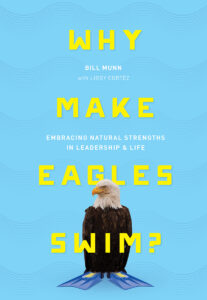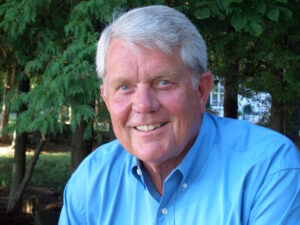Embrace Your Strengths
If you want to be a successful leader, don’t focus too much time and attention on weaknesses. Whether as an individual or as a team, it’s more productive to leverage strengths.
Leadership coach Bill Munn helps us do that with his innovative assessment tools and management training. For over 25 years, he has helped leaders uncover their natural characteristics to influence others. I recently spoke with him about his new book, Why Make Eagles Swim? Embracing Natural Strengths in Leadership & Life.
The Difference Between Skills and Attributes
I’m a big believer in managing to strengths, and your book provides a set of tools for doing this effectively. What’s a quick definition of an attribute? How is that different from a skill?
An attribute is an inherent, instinctive trait. Think of it like the wiring of a person’s internal microchip. Attributes determine our perceptions of the world and the way we behave toward it.
It’s not surprising that people can sometimes confuse attributes with skills. Here’s the key: skills are learned and practiced rather than instinctive.
For example, a person with a high Relational attribute exhibits an innate sensitivity to other people and their feelings. This person can’t help but feel sad when others are sad, happy when others are happy, etc. That’s not a skill; it’s a natural attribute.
Now let’s say that this same person wants to really leverage her Relational attribute, so she decides to practice some related skills. She might choose to hone her effective listening skills, to help her tune into other people for even more profound insight.
In this way, skills can enhance our strongest attributes. But they’ll never replace those innate characteristics.
The Myth of Well-Roundedness
You talk about 3 forces that fuel some negative biases. Let’s focus on #1: the myth of well-roundedness. It seems that this appears everywhere. Why is this one damaging to professional growth?
The myth of well-roundedness pervades our world today—this idea that we’re somehow supposed to be good at everything. What a damaging theory! That’s not how we’re built.
Just look at the most successful people—those you know, those in the public eye, those who have defined history. They’re full of flaws and failures, and they’re full of greatness. Do they become successful by trying to become well rounded? No. They focus on what they’re great at, so they are great.
The fact is, successful living requires prioritizing. If we were immortal, we could waste years trying to get a little better at our challenge attributes. But we have limited time. And if we focus on optimizing our power-alley attributes, we’ll see a much higher return on investment for the effort expended. Our teams and companies benefit much more from this approach—not to mention our own careers (and personal lives).
Think of it this way: An eagle could probably improve its swim stroke a bit, to become a more “well rounded” creature. But with that same effort, think what it could do for its flight speed and soaring height. So when was the last time you saw an eagle working on its backstroke?
Never! I love that example. Would you share an example or two of an attribute from the inventory?
Developer is our term for one who naturally encourages, teaches, and prioritizes other people’s growth and development. This person prefers working behind the scenes, rather than getting the spotlight for himself. Actually, Skip, Developers make great leadership bloggers—or coaches, teachers, mentors, etc. They’re also great leaders, because when people care about your growth, you want to follow them.
A Logician perceives the world in terms of cause, effect, and logic. She assumes that events flow rationally and that people do things for logical reasons. (As you can imagine, she’s an opposing attribute to the Relational we talked about earlier, who is so tuned into emotion and other “illogical” factors.) The Logician looks for data and analytics to describe situations and assumes that solutions lie in the facts.
How do I find out my own high and low attributes, my profile?
We actually use an array of tools to do this, including a questionnaire, assessment, and analysis exercises that you can do on your own or with a partner. The goal of all these tools is to help you define your own profile, which will consist of a few different categories:
- Power-alley attributes: Your most natural traits, the attributes you basically exhibit no matter what – in fact, it would be extremely difficult (if not impossible) for you to avoid demonstrating these traits.
- Functional attributes: These attributes (which we break down further into 3 functional levels) are like tools you keep in the garage rather than on your tool belt – they’re available to you, but it takes a bit of extra effort to access them.
- Challenge attributes: These are the 1 or 2 attributes at the bottom of your list – the things that you just don’t do really well, no matter how hard you work at it.
 When I’m working with others, knowing their attributes is as important as knowing my own. What’s the best way to do this (if I can’t have them take a test)?
When I’m working with others, knowing their attributes is as important as knowing my own. What’s the best way to do this (if I can’t have them take a test)?
This is where our tools for listening (and watching) for revelation become so valuable. Since our attributes are inherent and ingrained, we reveal them constantly in the things we do and say.
It’s analogous to a radio station constantly broadcasting. But to hear it, we have to tune in. Same with people. We constantly “broadcast” our attributes through our descriptions of events, our stories about people we liked or disliked, our reactions to outside stimuli – in short, through our response to life events.
Effective listening focuses on accurately tuning into the content of what the speaker says. That’s essential and always important. Listening for revelation, however, is an additional step that goes beyond content and unearths the speaker’s attributes.
It’s impossible to overstate how powerful this type of listening is.
Create More A More Effective Team
How do I use this to create more effective teams?
First, you teach your team that the attributes they find so irritating in others are actually the very traits (and people) best positioned to help them better perform, grow, and develop.
Second, you emphasize that there are no “good” or “bad” attributes. Each attribute brings something important and valuable to the table. This perspective helps people become intrigued by others’ behaviors. Team members soon stop thinking in terms of who they “like” and start supporting one another in incredible ways.
That’s the big picture. There are also many nuts-and-bolts tools for applying this concept in building, balancing, and growing your teams—team attribute matrices, team-building ideas, hiring practices, etc.
3 Times to Pair Opposites Together
When should you pair opposites together on a project?
There are many situations where this would make sense, but 3 of the most common are when success requires any of the following:
- High innovation
- Buy-in from a wide audience
- People needing to adjust to change
Why? Well, when high innovation is needed, varied viewpoints will help decrease your odds of missing a new idea or discounting it because of out-of-date paradigms.
When you need buy-in from a wide audience, the disparate attributes of your team can help you design pitches and presentations for wider, more universal appeal.
As you prepare for helping people adjust to change, the opposing attributes on your team will help increase your chance of identifying (and addressing) points of potential resistance in advance.
Make Performance Reviews More Effective
What ways can a leader make the performance review process more effective?
First, abandon the belief that you want people to improve where they’re naturally challenged. If your goal is great success, you want people to focus on their natural greatness and soar as high as they can with it, rather than fumbling around in the weeds, trying to get marginally better at something they’re not cut out for. This approach offers much bigger bang for your development buck.
Then, teach your team the attributes concept, so they understand what’s coming next.
Explain that you’re going to conduct performance reviews in a new way—one that’s focused on spurring them to optimize their high attributes.
Once you’ve prepared them for change with these first 3 steps, you’re ready to update your approach:
When you’re speaking with Joe the high Developer / low Logician, frame objectives in terms of how he can use his strongest traits to accomplish them.
So instead of this: “You are poor at managing the data, so too many mistakes are being made in your analysis, and we’re not getting the insight we need from your team. You need to be more precise, focus on improving your analytical skills, and tease out meaningful information from the numbers.”
Try this: “We both know you have strong analysts on your team, but personally, you’re not great at managing the data. What you are great at is encouraging your people to higher performance, so your ability with the data shouldn’t matter. I don’t care if you don’t know how to read a spreadsheet; as long as your people are motivated to perform, the results will show. Turn to your team’s strengths in analytics, and motivate them to take charge. We both know you’re a great motivator, so turn it on, Joe.”
This is a much more powerful means of spurring Joe to action—and a big, meaningful challenge for him. He’s far more likely to get to the goal when the path is defined by the attribute he understands best.
Embrace YOUR strengths! Are you READY to be an incredible leader? By signing up for FREE to Leadership Insights, you will be on your way![/subscribe]
Why Make Eagles Swim? Embracing Natural Strengths in Leadership & Life

